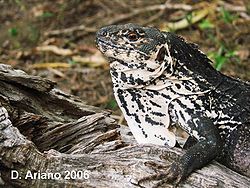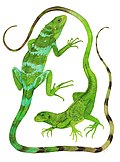| Ctenosaura palearis | |
|---|---|
 | |
| Guatemalan spiny-tailed iguana | |
| Scientific classification | |
| Kingdom: | Animalia |
| Phylum: | Chordata |
| Class: | Reptilia |
| Order: | Squamata |
| Suborder: | Iguania |
| Family: | Iguanidae |
| Genus: | Ctenosaura |
| Species: | C. palearis |
| Binomial name | |
| Ctenosaura palearis Stejneger, 1899 | |
 | |
Ctenosaura palearis, commonly known as the Motagua spiny-tailed iguana, is a species of spiny-tailed iguana endemic to the Motagua Valley in Guatemala.

